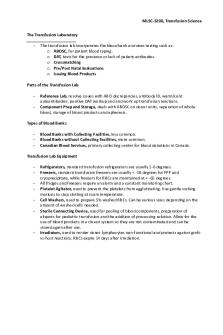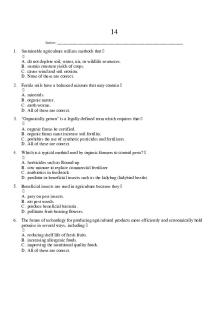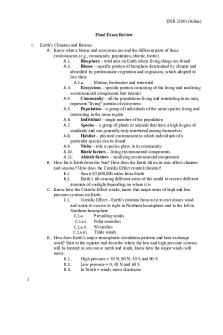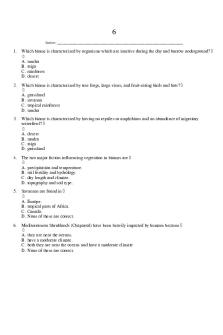Book Sol - Solution manual to \"Intro To Environmental Engineering 5/e\" PDF

| Title | Book Sol - Solution manual to \"Intro To Environmental Engineering 5/e\" |
|---|---|
| Author | Micah Mendoza |
| Course | Environmental Engineering |
| Institution | University of Minnesota, Twin Cities |
| Pages | 43 |
| File Size | 728.2 KB |
| File Type | |
| Total Downloads | 63 |
| Total Views | 158 |
Summary
Solution manual to "Intro To Environmental Engineering 5/e"...
Description
2-1
Solutions Manual for Introduction to Environmental Engineering 5th Edition by Davis Full clear download( no error formatting) at: http://downloadlink.org/p/solutions-manual-for-introduction-to-environmentalengineering-5th-edition-by-davis CHAPTER 2 SOLUTIONS
2-1
Expected life of landfill Given: 16.2 ha at depth of 10 m, 765 m3 dumped 5 days per week, compacted to twice delivered density Solution: a. Mass balance diagram Solid Waste 765 m3/d
Accumulated Solid Waste
b. Total volume of landfill (16.2 ha)(104 m2/ha)(10 m) = 1.620 x 106 m3 c. Volume of solid waste is ½ delivered volume after it is compacted to 2 times its delivered density (765 m3)(0.5) = 382.5 m3 d. Annual volume of solid waste placed in landfill (382.5 m3)(5 d/wk)(52 wk/y) = 9.945 x 104 m3/y e. Estimated expected life 6 3 1.620 10 m 16.29 or 16 years 9.945 10 4 m 3 y
NOTE: the actual life will be somewhat less due to the need to cover the waste with soil each day.
2-2
2-2
Estimated emission of dry cleaning fluid Given: 1 barrel (0.160 m3) of dry cleaning fluid per month, density = 1.5940 g/mL, 90% lost to atmosphere. Solution: a. Mass balance diagram Loss to atmosphere 0.160 m3 dry cleaning fluid Residue
b. Mass of dry cleaning fluid into tank 0.160 m 3 mo 1.5940 g mL 1000 mL L1000 L m 3 1000 g kg
255.04 kg mo
c. Mass emission rate at 90% loss (0.90)(255.04 kg/month) = 229.54 kg/month 2-3
Estimated emission of a new dry cleaning fluid Given: Problem 2-2, Volatility = 1/6 of former fluid, Density = 1.622 g/mL Solution: a. Mass balance diagram same as problem 2-2 b. Mass of dry cleaning fluid into tank 0.160 m 3 mo 1.6620 g mL 1000 mL L1000 L m 3 1000 g kg c. Mass emission rate at 1/6 volatility (1/6)(0.90)(265.92 kg/mo) = 39.89 kg/mo
265.92 kg mo
2-3
d. Savings in volume (note: 1.0 g/mL = 1000 kg/m3) Old dry cleaning fluid (from problem 2-2) Massout = (0.90)(255.04 kg/mo) = 229.54 kg/mo Vout
229.54 kg mo 0.1440 m 3 mo 1594 kg m 3
New dry cleaning volume Vout
39.89 kg mo 0.0240 m 3 mo 1622 kg m 3
Savings = (0.1440 m3/mo – 0.0240 m3/mo)(12 mo/y) = 1.44 m3/y 2-4
Annual loss of gasoline Given: Uncontrolled loss = 2.75 kg/m3 of gasoline Controlled loss = 0.095 kg/m3 of gasoline Refill tank once a week Tank volume = 4.00 m3 Specific gravity of gasoline is 0.80 Condensed vapor density = 0.80 g/mL Cost of gasoline = $0.80/L Solution: a. Mass balance diagram 2.75 kg/m3 loss
4.00 m3 of gasoline
b. Annual loss with splash fill method Loss = (4.00 m3/wk)(2.75 kg/m3)(52 wk/y) = 572 kg/y c. Value of fuel captured with vapor control
2-4
Mass captured = (4.00 m3/wk)(2.75 kg/m3 – 0.095 kg/m3)(52 wk/y) = 552.24 kg/y Value (note: 1.0 g/mL = 1000 kg/m3) 552.24 kg y1000 L m
3
$1.06 / L
$731.72 or $732/y
800 kg m 3 2-5
Mass rate of tracer addition Given: QRR = 3.00 m3/s, QTPR = 0.05 m3/s, detection limit = 1.0 mg/L Solution: a. Mass balance diagram (NOTE: Qout = QRR + QTPR = 3.05 m3/s) QTPR = 0.05 m3/s CTPR = ?
QRR = 3.0 m3/s CRR = 0
Tin Pot Run
QOUT = 3.05 m3/s COUT = 1.0 mg/L
Rappahannock River
b. Mass balance equation CRRQRR + CTRPQTPR = CoutQout Because CRR in = 0 this equation reduces to: CTPRQTPR = CoutQout c. Note that the quantity CTPRQTPR is the mass flow rate of the tracer into TPR and substitute values 1.0mg L
C TPRQ
TPR
3.05m 3 s
1000L 1kg 3 m 106 mg
86400s 264 kg d d
d. Concentration in Tin Pot Run C C TPR
264 kg d10 6 mg kg
Q TPR
TPR
0.05 m 3
Q TPR
s86400 s d1000 L m 3
61 or 60 mg/L
2-5
2-6
NaOCl pumping rate Given: NaOCl at 52,000 mg/L Piping scheme in figure P-2-6 Main service line flow rate = 0.50 m3/s Slip stream flow rate 4.0 L/s Solution: a. Mass balance at return of slip stream to main service line QIN = 0.50 m 3/s C IN = 0.0 mg/L
QSS = 4.0 L/s C SS = ?
Slip Stream Main service line
QOUT ≈ 0.50 m3/s COUT = 2.0 mg/L
b. Calculate CSS Mass out = Mass in (0.50 m3/s)(2.0 mg/L)(1000 L/m3) = (4.0 L/s)(CSS) 1000 mg/s = (4.0 L/s)(CSS) 1000 mg s C SS 250 mg L 4.0 L s
c. Mass balance at the junction of pump discharge and slip stream line
2-6
Pump Discharge
QIN = 4.0 L/s C IN = 0.0 mg/L
QPUMP = ? Cdaytank = 52,000 mg/L
Slip stream line
QOUT ≈ 4.0 L/s COUT = 250.0 mg/L from “b” above
d. Calculate QPUMP Mass in = Mass out (QPUMP)(52,000 mg/L) = (4.0 L/s)(250 mg/L) 4.0 L s250 mg L QPUMP 0.0192 L s 52,000 mg L 2-7
Dilution of NaOCl in day tank Given: Pump rated at 1.0 L/s 8 hour shift NaOCl feed rate 1000 mg/s Stock solution from Prob 2-6 = 52,000 mg/L Solution: a. Mass of NaOCl to be fed in 8 h (8 h)(3600 s/h)(1000 mg/s) = 2.88 x 107 mg b. Volume of stock solution 7 2.88 10 mg 5.54 10 L 2 or 0.554 m 52,000 mg L
3
c. Volume of dilution water (8 h)(3600 s/h)(1.0 L/s) = 2.88 x 104 L or 28.8 m3 d. Check
2-7
28.8 m3 + 0.554 m3 = 29.4 m3 < 30 m3 2-8
Volume of sludge after filtration Given: Sludge concentration of 2%, sludge volume = 100 m3, sludge concentration after filtration = 35% Solution:
a. Mass balance diagram Filter
Vin = 100 m3 Cin = 2%
b. Mass balance equation Cinin = Coutout c. Solve for out Vout
C in Vin C out
d. Substituting values 0.02100m Vout 0.35 2-9
3
5.71m3
Hazardous waste incinerator emission Given: Four nines DRE Mass flow rate in = 1.0000 g/s Incinerator is 90% efficient Solution: a. Mass balance diagram
Vout = ? Cout = 35%
2-8
Mass out
Mass in
Incinerator
Scrubber
b. Allowable quantity in exit stream Mass out = (1 - DRE)(Mass in) = (1 – 0.9999)(1.0000 g/s) = 0.00010 g/s c. Scrubber efficiency Mass out of incinerator = (1 – 0.90)(1.000 g/s) = 0.10000 g/s Mass out of scrubber must be 0.00010 g/s from “b”, therefore 0.1000 g s 0.00010 g s 0.999 or 99.9% 0.1000 g s 2-10
Sampling filter effi ciency Given: First filter captures 1941 particles Second filter captures 63 particles Figure P-2-10 Each filter has same efficiency Solution: a. Note that C3 C2 and C2 C1 b. The concentration C2 is C2 = C1 - 1,941 c. Substitute efficiency for C1 and C2
2-9
63 1941 1941 d. Solve for η 63 = 1,941 - 1941η -1,941η = 63 – 1941 = -1,878 1878 0.9675 1941 e. The efficiency of the sampling filters is 96.75% 2-11
Concentration of nickel in wastewater stream Given: Figure P – 2-11, concentration of plating solution = 85 g/L, drag-out rate = 0.05 L/min, flow into rinse tank = 150 L/min, assume no accumulation in tank. Solution: a. Mass balance diagram Qdragout = 0.05 L/min Cnickel = ? Qrinse = 150 L/min Crinse = 0
Qin = 0.05 L/min Cin = 85 g/L Qrisne = 150 L/min Cnickel = ?
b. Mass balance equation QinCin + QrinseCrinse – QdragoutCnickel - QrinseCnickel = 0 c. Because Crinse = 0 this reduces to QinCin = QdragoutCnickel + QrinseCnickel d. Solving for Cnickel
2-10
Cn ick el
Qin C in Q d rago u t Qrin se
e. Substituting values 0.05 L min 85 g L C nickel 0.05 L min 150 L min 2-12
28 mg L
Counter-current rinse tanks Given: Figure P-2-12, Cn = 28 mg/L, assume no accumulation in tanks Solution: a. Because there are two unknowns we must set up two mass balance equations and solve them simultaneously. The mass balance diagrams are: QR = 0.05 L/min Cn-1 = ?
#2
QR = 0.05 L/min Cin = 85 mg/L
QW = ? C = 28 mg/L
QR = 0.05 L/min Cn = 28 mg/L
QR = 0.05 L/min Cn-1 = ?
n
QW = ? Cn = 28 mg/L
QW = ? Cn-1 = ?
b. Mass balance equation, starting with the right-hand rinse tank (#1) (Cn-1)(QR) + (CW)(QW) = (Cn)(QR) + (Cn)(QW) c. Note that (Cw)(QR) = 0 because CW = 0, then solve for QW QW
QW
Cn 1 Q R C Q n Cn QR C n 1 C n Cn
R
#1
QW = ? CW = 0
2-11
d. Mass balance equation for tank at the left hand side (#2) (Cin)(QR) + (Cn)(QW) = (Cn-1)(QR) + (Cn-1)(QW)
2-12
e. Solving for Cn-1 C n1
Cin Q RC Q n QR QW
W
f. Substitute solution for tank #2 into solution for tank #1 and simplify C Q C Q Q R in R n W Cn Q R QW Cn
QW
2
Q
Q Q
W
R
Q
2 R
W
Cn
C in
0
Cn
This equation is a quadratic equation with a = 1, b = QR and c Q
2 R
Cn C C
in
n
g. The solution to the quadratic equation is 1 2
QW
Q
Q
R
R
2
4Q
2
R
Cn
C in
Cn
2
h. Substituting the values for the variables, note Cn is in mg/L and Cin is in g/L 1 2 2 0.028 85 2 0.05 0.05 40.05 0.028 QW 2 QW
0.05 5.51 2.73 or 3 L/min 2
2-13 Multiple countercurrent rinse tanks Given: EPA equation for multiple tanks; Figure P-2-13 Solution:
2-13
Problem 2-13 Multiple Rinse Tanks
Rinsewater flowrate, L/min
1000
100
10
1
0.1 0
1
2
3
4
5
6
Numbr of Rinse Tanks
2-14
Figure S-2-13: Multiple rinse tanks Oxygen concentration in bottle Given: Starting O2 concentration = 8 mg/L, rate constant of 0.35 d-1 Solution: a. General mass balance equation for the bottle is Eqn 2-28 Ct = Coe-kt b. With Co = 8.0 mg/L and k = 0.35, the plotting points for oxygen remaining are: Day 1 2 3 4 5
Oxygen Remaining, mg/L 5.64 3.97 2.79 1.97 1.39
2-14
Problem 2-14 BOD Decay 9 8 7
BOD, mg/L
6 5 4 3 2 1 0 0
1
2
3
4
5
Day
Figure S-2-14: BOD decay 2-15
Decay rate for anthrax die-off Given: Die-off data points no./mL 398 251 158
Time, min 0 30 60
Solution: a. Assume this is 1st order decay (Eqn 2-28) Ct = Coe-kt b. Using two values (t = 0 and t = 60 min), set Co = C60 and solve for k 158 = 398e-k(60 min)
6
2-15
158 k 60 e 398 0.397 = e-k(60) Take the natural log of both sides ln(0.397) = ln[e-k(60)] -0.924 = -k(60) k = 0.0154 min-1 (or k = 22.18 d-1) c. Check at t = 30 min Ct = 398e-(0.0154)(30) = 250.767 or 251 2-16
Chlorine decay in water tower Given: 4000 m3 water tower Initial chlorine concentration = 2.0 mg/L k = 0.2 h-1 Shut down for 8h Assume completely mixed batch reactor Solution: a. Because there is no influent or effluent, the concentration is described by Eqn 2-28. Ct kt e Co b. Substituting values and solving for Ct (Note: 8h = 0.33 d) Ct = 2.0 exp [-(1.0 d-1)(0.33 d)] Ct = 2.0(0.72) = 1.44 mg/L c. Mass of chlorine to raise concentration back to 2.0 mg/L Concentration change required 2.0 mg/L – 1.44 mg/L = 0.56 mg/L
2-16
Mass required in kg 0.56 mg L4000m 3 1000 L m3 106 mg kg 2-17
2.25 or 2.3kg
Expression for half-life Given: Batch reactor Solution: a. Mass balance equation (Eqn 2-16) dM dIn dOut dt kCV dt dt
b. Since it is a batch reactor with no “in” or “out”, this reduces to dM kCV dt c. Because the reactor volume is constant the change in mass may be written as dM dC V dt dt so, dC V kCV or dt
dC kC dt
d. Integrating Cout = Cine-kt e. For half the substance to decay C out 1 C in 2 f. So the time for ½ the substance to decay is
2-17
1 kt e 2 Taking the natural log of both sides, ln(0.5) = ln(e-kt) -0.693 = -kt t 2-18
0.693 k
Amount of substance remaining after half-li fe Given: k = 6 months-1, 1, 2, 3, and 4 half-lives, initial amount = 100% Solution: a. Recognizing the half-life concept, then the amount remaining is by observation Half Life 0 1 2 3 4
Amount Remaining, % 100 50 25 12.5 6.25
b. By equation 0.693 0.1155mon ths t1 2 6mo1 c. For one half life Ct = 100%e- (6 /months)(0.1155 months) Ct = 50% d. For two half lives (2*0.1155 = 0.231 months) Ct = 100%e- (6 /months)(0.231 months) Ct = 25.01% or 25%
2-18
etc. 2-19
Mixing time to achieve desired energy content Given: CMFR, current waste energy content = 8.0 MJ/kg, new waste energy content = 10.0 MJ/kg, volume of CMFR = 0.20 m3, flow rate into and out of CMFR = 4.0 L/s, effluent energy content = 9 MJ/kg. Solution: a. Mass balance diagram at t < 0 Q = 4.0 L/s Cin = 8 MJ/kg
Q = 4.0 L/s Cout = 8 MJ/kg
b. Step change in influent concentration at t ≥ 0 Cin = 8 MJ/kg increases to Cin = 10 MJ/kg c. Assuming this is non-r eactive then the behavior is as shown in Figure 2-8 and Eqn 230 applies. Using the given values: 9
MJ t / MJ MJ t / 1e 8 e 10 kg kg kg
Compute theoretical detention time: 0.20m 3 50s 4.0 L s10 3 m 3 L Solving for the exponential term: 9 8e t / 50 10 10e t / 50 1 8 10e t / 50 0.50 e t / 50 Taking the natural log of both sides
2-19
0.693
t 50
t = 34.66 or 35 s 2-20
Repeat Problem 2-19 with new waste at 12 MJ/kg Given: Data in Problem 2-19 Solution: a. See Problem 2-19 for initial steps 9 8e t / 50 12 12e t / 50 0.75 e t / 50 Taking the natural log of both sides: 0.288
t 50
t = 14.38 or 14 s
2-21
Time for sample to reach instrument Given: 2.54 cm diameter sample line Sample line is 20 m long Flow rate = 1.0 L/min Solution: a. Calculate area of sample line 2 2.54cm 5.07cm 2 A 4 In m2
2-20
5.07cm 2 2 4 2 2 5.07 10 m 4 m 10 cm b. Speed of water in the pipe 1.0 L min 103 m 3 L 1.97 m min 5.07 10 4 m 2
u
c. Time to reach sample t
20m 10.13 or 10 min 1.97 m min
d. Volume of water (ignoring 10 mL sample size) = (1.0 L/min)(10 min) = 10 L 2-22
Brine pond dilution Given: Pond volume = 20,000 m3, salt concentration = 25,000 mg/L, Atlantic ocean salt concentration = 30,000 mg/L, final salt concentration = 500 mg/L, time to achieve final concentration = 1 year. Solution: a. Assuming the pond is completely mixed, treat as a step decrease in CMFR and use Eqn 2-33 and solve for θ. 1y ear 500 25000 exp 0.020 exp
1y
Take the natural log of both sides 3.912
1y
1 0.2556y 3.912
2-21
b. Recognize that V
Q
and solve for Q 0.2556y
Q
20000m 3 Q
20000m 3 78, 240 m 3 y 0.2556y
c. Convert to units of m3/s 1 78,240 m 3 y
1
0.0025 m 3 s
365 d y 86400 s d
2-23
Venting water tower after disinfection Given: Volume = 1,900 m3, chlorine concentration = 15 mg/m3, allowable concentration = 0.0015 mg/L, air flow = 2.35 m3/s. Solution: a. Assume the water tower behaves as CMFR and apply Eqn 2-33 1900m3 808.51s 2.35 m 3 s Convert concentration to similar units (0.0015 mg/L)(1,000 L/m3) = 1.5 mg/m3 Now solve Eqn 2-33 3 1.5 mg m 15 mg
t
m 3 exp
808.51s
2-22
t 0.10 exp 808.51s Take the natural log of both sides 2.303
t 808.51s
t = 1,861.66 s or 31 min or 30 min 2-24
Railroad car derailed and ruptured Given: Volume of pesticide = 380 m3 Mud Lake Drain: ν = 0.10 m/s, Q = 0.10 m3/s, L = 20 km Mud Lake: = 40,000m3 Assume pesticide is non-reactive, assume pulse injection and lake is CMFR, assume drain behaves like PFR Solution: a. Treat as two part problem: a PFR followed by a CMFR b. Time for pulse to reach Mud Lake L 20km1000 m km 200,000s t u 0.10 m s
or 2.31 d
c. Pulse injection into CMFR. If it is completely mixed, then the initial concentration as the pulse enters the lake is Co. To achieve 99% removal, Ct = (1-0.99)Co = 0.01Co. Ct 0.01C o 0.01 Co Co d. Using Eqn 2-33 with V Q
40000m3 400,000s 0.10 m 3 s
0.01 exp
t 400,000
Taking the natural log of both sides
2-23
4.605
t 400,000
t = 1,842,068 s or 30,701 min or 511 h or 21.3 d 2-25
Fluoride feeder failure Given: Rapid mix tank, = 2.50 m3 Find concentration = 0.01 mg/L, initial concentration = 1.0 mg/L, Q = 0.44 m3/s Pipe, L = 5 km, ν = 0.17 m/s Solution: a. Treat as two part problem: a CMFR followed by PFR b. Use Eqn 2-27 to find θ and Eqn 2-33 to solve for t V Q 0.01
2.5m 3 5.68s 0.44 m 3 s
exp
1.0
t
5.68s
t = 26.16 s c. Assuming pipe behaves as PFR, the time for the last parcel at 0.01 mg/L to travel the length of the pipe is L 5km1000 m km u 0.17 m s
29,411s
d. Total time ttotal = 26.16 + 29,411.76 = 29,437.92 s or 490.6 min or 8.17 h 2-26
Rate constant for sewage lagoon Given: Area = 10 ha, depth = 1 m, flow into lagoon = 8,640 m3/d, biodegradable material = 100 mg/L, effluent must meet = 20 mg/L, assume 1st order reaction. Solution:
2-24
a. There are two methods to solve this problem: (1) by using mass balance, (2) using equation from Table 2-2 b. First by mass balance Decay Cin = 100 mg/L Qin = 8,640 m3/d
Cout = 20 mg/L Qout = 8,640 m3/d
Lagoon
The mass balance equation is dM C in Q in C outQ out kC dt
lagoon
V
Assuming steady state, CMFR then dM 0 and C lagoon = Cout dt So, CinQin – CoutQout – kCout = 0 Solving for k CinQin – CoutQout = kCout k
C in Q in C outQout C out V
Note that 1 mg/L = 1 g/m3 k
100 g m 3 8640 m3 d20 g m 3 8640 m 3 d 20 g m 3 10ha 10000 m 2 ha 1m
k = 0.3456 d-1 c. Repeat using Table 2-2 equation for CMFR and 1st order reaction
2-25
C
Co 1 k
t
2 V 10ha 10000 m ha 1m
11.574d
8640 m 3 d
Q 20 mg L
100 mg L 1 k11.574d
Solve for k 0.20
1 1 k11.574d
5.00 = 1 + k(11.574 d) k 2-27
4.00 0.3456d 1 11.574d
Rate constant for two lagoons in series Given: Data from Problem 2-26, two lagoons in series, area of each lagoon = 5 ha, depth =1m Solution: a. Mass balance diagram Co Q
C1, Q Lagoon 1
Ct Q Lagoon 2
Thus, the output from the 1st lagoon is the input to the 2nd lagoon. Solve the problem sequentially. b. Calculate volume and hydraulic retention time = (5 ha)(10,000 m2/ha)(1 m) = 5.0 x 104 m3 V 5.0 10 m 4 3 5.787d Q 8640 m 3 d
2-26
c. Using Table 2-2 C
1
Co 1 k
d. Because C1 = Co for the second lagoon and the second lagoon has the same relationship C
C1 1 k
t
Substituti...
Similar Free PDFs

Solution manual to Chapter 3
- 51 Pages

ENGINEERING ECONOMY SOLUTION MANUAL
- 57 Pages

Intro to textiles
- 8 Pages

Intro to Med Term
- 41 Pages

Intro to Tinker CAD
- 3 Pages

Intro to Oscilloscopes
- 8 Pages

Intro to Sociology
- 34 Pages

Intro to Transfusion Science
- 3 Pages
Popular Institutions
- Tinajero National High School - Annex
- Politeknik Caltex Riau
- Yokohama City University
- SGT University
- University of Al-Qadisiyah
- Divine Word College of Vigan
- Techniek College Rotterdam
- Universidade de Santiago
- Universiti Teknologi MARA Cawangan Johor Kampus Pasir Gudang
- Poltekkes Kemenkes Yogyakarta
- Baguio City National High School
- Colegio san marcos
- preparatoria uno
- Centro de Bachillerato Tecnológico Industrial y de Servicios No. 107
- Dalian Maritime University
- Quang Trung Secondary School
- Colegio Tecnológico en Informática
- Corporación Regional de Educación Superior
- Grupo CEDVA
- Dar Al Uloom University
- Centro de Estudios Preuniversitarios de la Universidad Nacional de Ingeniería
- 上智大学
- Aakash International School, Nuna Majara
- San Felipe Neri Catholic School
- Kang Chiao International School - New Taipei City
- Misamis Occidental National High School
- Institución Educativa Escuela Normal Juan Ladrilleros
- Kolehiyo ng Pantukan
- Batanes State College
- Instituto Continental
- Sekolah Menengah Kejuruan Kesehatan Kaltara (Tarakan)
- Colegio de La Inmaculada Concepcion - Cebu







